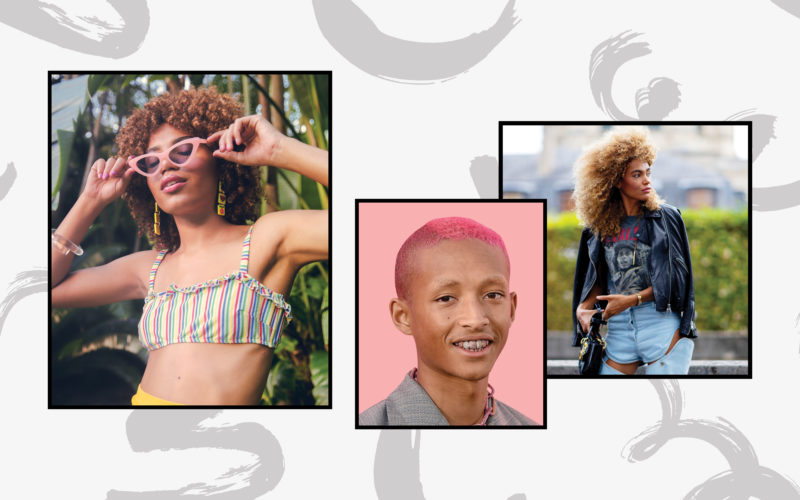Welcome to Texture Talk, a column that celebrates and deep dives into the dynamic world of curly hair, from crowns of curls that are free flowing to strands that are tucked away in a protective style.
Hair colouring is a chemical process that changes more than just your hair’s hue — especially if you’re blessed with natural curls — so it’s important to do your research and go in prepared. The first order of business is, of course, booking a consultation with your colourist. This should be an information-gathering conversation, and “there has to be honesty on both sides,” says Praise Okwumabua, stylist and owner of Freshair Boutique in Winnipeg. “Sometimes clients are timid when it comes to expressing what they want, so be clear.” Photos of the coloured curls you’re after are helpful; send the colourist an inspiration pic of the colour you hope to achieve, plus one of your current hair colour, prior to the consultation. Most importantly, Okwumabua stresses, clients should be empowered to ask for photos of the colourist’s past work. “You want to see that they know how to manipulate your hair type,” she says. “If you have no evidence they’ve done it before, or if they’re dismissive and act like the process will be the same for your type 3 or 4 curls as it would be for anyone else, be leery.”
Prep
Once you’ve both agreed on your desired shade, there are some pre-appointment steps you can take to enhance your results before you settle into the chair. First, shampoo and detangle your hair the day before the big appointment. Despite what you may have heard, “dirty hair isn’t better,” says Keina Morgan, a Toronto-based curl expert and owner of Urban Curls Boutique. You want clean hair with no heavy oils or other products that might block the colour from penetrating. Clients with curl patterns in the type 2 to 3 range can arrive at the salon with their curls in natural form. For type 4 curls, “it’s best to come in with tight coils stretched out,” says Morgan. “This makes it easier to apply the product and will result in less pulling on your scalp. The product will also be absorbed deeper into the hair, and we’ll have to use less of it.”
Colour
Now for the dyeing process…The procedure lifts and opens up the hair cuticle to allow the colour to seep in. But it also allows moisture to escape, leading to dry hair. “Think of the cuticle layer of your hair as a pine cone,” says Morgan. “With virgin hair, the pine cone is tight and sealed. The developer used in a colouring service opens up the cuticle layer, so the pigment can penetrate, and the cuticle is then always lifted.” This puts Black hair, which is naturally drier and more fragile, in an even more delicate, breakage-prone state. All coloured hair is compromised, especially when you get into lighteners, says Okwumabua. “So if you don’t follow an after-care regimen, your hair is going to break off for sure, particularly if you have type 3 or 4 curls.”
After-care
Now that you’ve left the salon with your desired hue and snapped the perfect selfie to post on Instagram, it’s time to chill out—literally. To preserve the colour in freshly dyed hair, it’s best to avoid hot temperatures. “Every time you pass a flatiron over your hair or blow-dry it, you open up the cuticle a little bit, causing the colour to fade,” says Okwumabua. Diffusing is less damaging, since the hot air isn’t directly hitting your strands, but air-drying and twist-out styling are ideal for maintaining colour. The minimal- heat rule applies in the shower, too. “Using cooler water will help keep the cuticle closed, which keeps colour in your strands for longer,” says Morgan. What’s in your hair-care lineup plays a major role in rebuilding colour- treated curls and preserving vibrancy, too. Morgan suggests a sulfate-free no- or low-lather shampoo, a keratin leave-in treatment and a protein-rich deep-conditioning mask. And investing in a bonnet or using a silk or satin pillowcase overnight will go a long way toward reducing frizz and maintaining moisture in curls, says Okwumabua.
To DIY or not to DIY…
Thinking about executing this whole process at home? Unfortunately, the hair pros don’t recommend trying to achieve coloured curls yourself. “After last year’s initial lockdown, we had to do a lot of fixing,” says Morgan. “You’ll never achieve the colour that’s on the front of the box—ever,” adds Okwumabua. But if your heart is set on DIYing, “talk to a stylist you trust and who will support you and give you the best tips,” advises Okwumabua. Both experts strongly recommend using a semi-permanent formula only—the type that will fade over several shampoos. Morgan suggests going just one shade darker than your hair colour. “It’s going to lift and lighten over time, and you don’t want lines of demarcation left in the hair,” she says. When shopping, buy multiple boxes of dye to make sure you have enough product to work through dense curls and finish the job. Morgan suggests two boxes if you have short to medium hair and four boxes if you have medium to long hair. Start by doing a patch and strand test to make sure you’re not allergic to the formula and to see what the results will be like before you mess with your entire mane. Don’t say we didn’t warn you!
Missed our last Texture Talk column? Click here.
